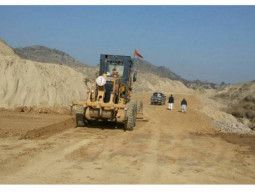
KARACHI: Industrial development is driven by knowledge creation and enhancement of innovative capabilities within an economy. Investments in innovation must accompany investments in physical capital to improve competitiveness.
Although several developing countries may rely on the import of foreign machinery and technology to manufacture their output, as is generally the case in Pakistan, local innovative capabilities still play an important role to determine the most efficient mix of resources for production.
Innovation and knowledge creation is essential for economic growth. Even if the scourge of intellectual property theft and counterfeiting of goods is lessened, innovation and knowledge creation requires regular exchange of information and collaboration between research centres, universities and industries.
'CPEC has set foundation for industrial cooperation'
East Asian economies invested heavily in human capital, research and development (R&D) and in institutions to create a business environment conducive for growth. Today, a large percentage of global industrial production takes place in East Asia. China, Japan and Republic of Korea lead the way in industrial development.
Innovation and knowledge creation has been a contributing factor to their industrial development. Their level of innovation can be gauged by the number of patent applications filed by residents, scientific and technical journal articles published, percentage of GDP spent on R&D and the number of researchers per million people.
According to the World Bank’s World Development Indicators, the three countries have one of the highest numbers of patent applications filed by residents in 2014 and contribute to approximately 25% of the scientific and technical articles published globally.
Japan and the Republic of Korea report one of the highest expenditures on R&D as a percentage of GDP, while China has made large strides in increasing the importance of R&D in the previous decade. As researchers innovate new knowledge, products and processes, innovation has a direct impact on the sustainability of industrial output. There are important lessons to be learnt from the East Asian economies on the contribution of innovation and knowledge creation to industrial development. Although Pakistan is at an earlier stage of industrial development in comparison to the East Asian economies and knowledge-intensive industries are not as prominent, the level of innovation in Pakistan is still rather dismal.
Initiatives to promote innovation
However, the government has introduced several initiatives to promote innovation. It has recently announced over 10,000 PhD scholarships to the United States. Pakistan Vision 2025 by the Planning Commission acknowledges the development of a knowledge economy as a priority area. In order for such initiatives to be successful, it is important that linkages between industries and academia are promoted through research collaborations in Pakistan to foster innovation and knowledge creation.
Construction of industrial free zone in Gwadar begins
The Global Innovation Index (GII) developed by Cornell University, INSEAD and the World Intellectual Property Organization (WIPO) is a tool to analyse the quality of innovation through creation of knowledge, technology and creative outputs within a country.
This index provides useful information on the innovative capabilities within an economy and considers measures beyond the more traditional methods commonly used to measure innovation.
The index takes into account indicators on innovative capabilities such as presence of viable institutions, the amount of human capital and research, the quality of infrastructure, and the sophistication of markets and businesses.
As the level of innovation within an economy is an important driver for industrial growth, the findings reported in the GII are crucial for policymakers, researchers, local entrepreneurs and foreign investors. Unfortunately, Pakistan ranks low across several indicators, which is a cause of concern.
The analysis by GII lists strengths and weaknesses. The report published in 2016 suggests that the domestic market scale, high-tech imports as a percentage of trade, information and communication technology (ICT) service imports as a percentage of total trade, high-tech and medium-tech output as a percentage of total output and ICT services exports as a percentage of total trade are strengths for Pakistan based on their individual rankings.
Pakistan has performed relatively well on the number of citations the publications of researchers have received and on the average score on the QS rankings for the top 3 universities in the country.
However, the quality of general infrastructure present within the country, and the condition of human capital and research, which include the level of expenditure on education, the number of years a child is expected to attend school and the lack of R&D by the top 3 global companies are listed as weaknesses.
Pakistan ranks poorly in terms of industry and university research collaboration and in the ability to use creativity for innovation. Therefore, there is not only a need to improve the quality of infrastructure, human capital and research, but also establish linkages between industries and universities.
According to UNCTAD stat, global exports in the fashion industry grew at more than an average of 8% per year and in the jewellery design industry grew at more than an average of 15% per year between 2003 and 2012.
Innovation and knowledge creation by experts across different disciplines, such as physical sciences, arts and social sciences, will generate much needed export revenue for Pakistan. Unfortunately, Pakistan has yet to become a party to UNESCO’s Convention on the Protection and Promotion of Cultural Expressions, which has been ratified by India and Bangladesh and accepted by Afghanistan.
Such conventions emphasise the role of creative industries on sustainable development. The government must make efforts to not only produce good researchers but also provide them with viable incentives.
The writer is an Assistant Professor of Economics & Research Fellow at CBER, IBA
Published in The Express Tribune, September 19th, 2016.
Like Business on Facebook, follow @TribuneBiz on Twitter to stay informed and join in the conversation.






















































COMMENTS
Comments are moderated and generally will be posted if they are on-topic and not abusive.
For more information, please see our Comments FAQ